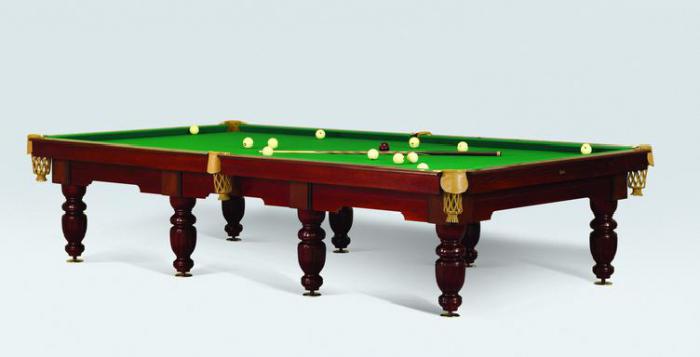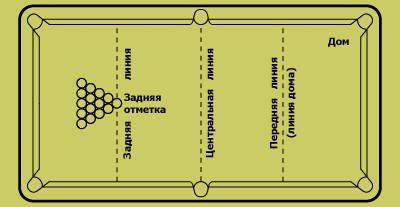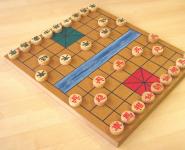Basic rules for playing billiards
Nowadays, billiards has become a very popular game. It has ceased to be just entertainment, but has become a kind of lifestyle that trains concentration, dexterity and determination. Many options for this pastime with their own rules and characteristics can confuse any novice player. The article tells about the history of this entertainment and explains the rules of the billiards game of the most popular versions.
History of billiards
There are many controversies around the history of billiards. China and Egypt are considered the birthplace of this game. In Europe, the first mentions of billiards are found in England. Even the name "billiards", from the Old Saxon bal-yard - bal-ball, yard-cue, stick, shows that this entertainment was known in this country, it only looked like modern croquet. Gradually, the game moved from the open space to the room, to a table with a green covering, reminiscent of grass on a lawn, with small bumpers around. Initially, the game was played on a table with six pockets and wickets, the game was played with two balls and a peg. In the 18th century, only balls and pockets remained on the table. This happened in France, which is why they say that this is the European birthplace of billiards. In the same place, in 1674, the first rules for the game of billiards were published. In England, where almost every city had public pool tables, the rules of the game were refined and expanded. In the same place, in the 16th century, the word "cue" appeared.

Evolution of the game
In the 18th century, the game began to develop actively. The industrial revolution played a significant role in this. For the convenience of the game, chalk was first used, which reduced the friction between the ball and the cue, and then they began to use a leather tip to get twisted blows. Thanks to this leather patch, the game of avid billiard players has become so virtuosic that the balls can easily move along different trajectories and even jump over each other. Billiards gradually underwent many transformations - it became a collapsible cue, the sides of the table began to be upholstered with rubber, cloth as upholstery began to be used everywhere. The debate of billiards specialists was even about the shape of the inner walls of the table, which also underwent several changes. The rules of the billiards game gradually became uniform. By about 1850, this game began to look the way we see it today.

History of Russian billiards
Billiards came to Russia under Peter the Great and quickly spread to public places, especially taverns. Since this entertainment developed autonomously in Russia, over time, Russian versions of the game appeared, and their own rules for the game of billiards appeared. At the beginning of the 19th century, the inventory for games was in great variety and in the absence of proportionality between the details, this often led to the fact that the tables were of different sizes, the balls were either too small, or did not fit into the pockets, etc. Competitions in each new place equalized the chances of beginners and professionals, because of which interest in the game was lost.
It was only in 1850 that A. Freiberg, who ran the St. Petersburg billiard factory and was a good player himself, created a model of a six-hole billiard table that met the standard requirements: all balls get into the pocket only with accurate shots. To ensure the necessary complexity of the game, the diameter of the balls was made only a few millimeters less than the width of the pockets, an accidental fall of balls into the middle pocket was excluded, and short mouths were made at the pockets to prevent the balls from getting stuck.

Russian billiards. Peculiarities
Russian billiards has more than 40 different types. Due to the fact that it existed in a semi-legal state in our country, there were no official competitions for it. Each billiard room had its own rules. The changes came in the 80s, when the Billiard Sports Federation was created. The rules for playing Russian billiards were unified, a system of tournaments and refereeing was developed. The general features typical for Russian billiards in the Russian and Moscow pyramids, American and other basic Russian variations of this game were generalized. The rules of the Russian billiards game were officially established by the National Billiard Sports Federation in 1994.
Russian billiards is not a specific game, but rather a collective term. Externally, Russian billiards is distinguished by white, large balls of the same color. For the complexity of the game, the pockets are smaller and the edges are sharpened, so it is more difficult to get into it. A long and heavy cue also complicates the game. The inner lining of the table is always green.

Russian billiards. General rules
The basic rules of the Russian billiards game describe the course of the game with a strike. It is made with the front part of the cue in the direction of its longitudinal axis, while at least one foot must touch the floor. Otherwise, he is fined. The right to first hit is enacted by striking both players simultaneously from the hand at the cue-ball from the house towards the tailgate. The one whose ball, reflected from the back side of the table, stops closer to the front side than the opponent's, has the right of the first move. The winner of the rally either takes the first kick or concedes the kick to an opponent. The players start the next games in turn, only before the decisive game the rally is played again.
Before the start of the game, 15 balls are set to each other in a certain way using a special shape in the form of a triangle. The cue ball is considered to be in play from the moment the cue sticker touches it. Balls hit by the first hit into the pocket are counted. Balls are considered pocketed if, when hit correctly, they are pocketed. If the ball jumped out of the table fence, but returned back to the table, it is considered to be in play. If, at the same time, he fell on the side or the floor, he was touched by any object - the player's sleeve, cue, chalk, etc. - he is considered to have jumped out and is put back on the table. It is exhibited in different versions of the game in those places that indicate the rules of the billiards game. An American woman, for example, prescribes placing the cue ball on a general basis. In this case, the player is not penalized if an object ball has flown out, and is penalized if the cue ball has flown out. The beginning of the strike is considered from the moment the cue touches the cue ball, and the end - only after the movement of all balls on the table has stopped, including rotation. The opponent starts the game if, after the hit of the previous player, the cue ball has not touched any ball or there has been a violation of the rules.


